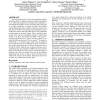Free Online Productivity Tools
i2Speak
i2Symbol
i2OCR
iTex2Img
iWeb2Print
iWeb2Shot
i2Type
iPdf2Split
iPdf2Merge
i2Bopomofo
i2Arabic
i2Style
i2Image
i2PDF
iLatex2Rtf
Sci2ools
AGENTS
2001
Springer
2001
Springer
An assistive robotic agent for pedestrian mobility
The goal of this project is to develop a pedestrian mobility aid for the elderly. In order for this type of assistive technology to be useful and accepted by its intended user community, it must enhance the abilities of users, not replace them. This leads to an agent architecture in which the agent must operate without hindering the user’s ability to take direct action when they choose. In other words, the agent cannot simply be a proxy for the user’s actions. The agent must select its own goals based on observations of its user’s actions. This is crucial not only because users may have diminished capacity to explain their actions to an agent, but because the ability of the agent to correctly interpret the user’s goals is tied to its ability to act while still allowing the user to “feel in control”. We present a mobility aid, i.e. a wheeled walker, which varies its goals and level of activity based on an estimation of its user’s intentions. The assistive agent often take...
| Added | 28 Jul 2010 |
| Updated | 28 Jul 2010 |
| Type | Conference |
| Year | 2001 |
| Where | AGENTS |
| Authors | Glenn S. Wasson, James P. Gunderson, Sean Graves, Robin A. Felder |
Comments (0)

